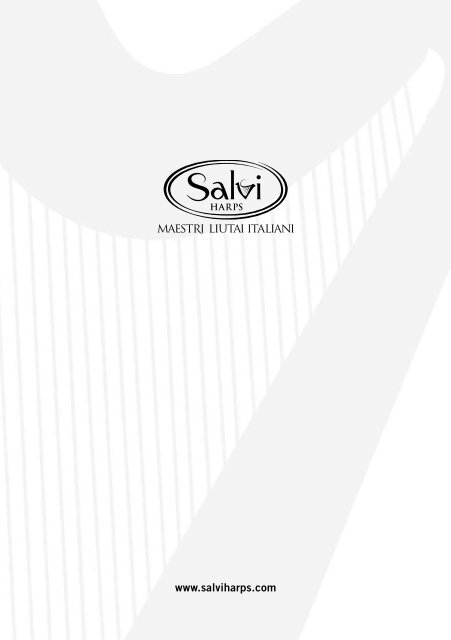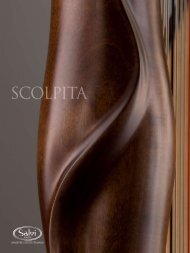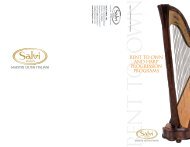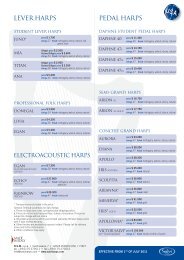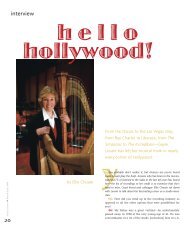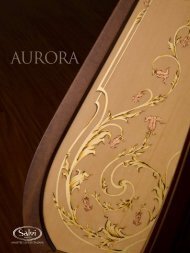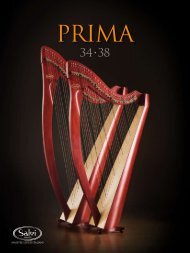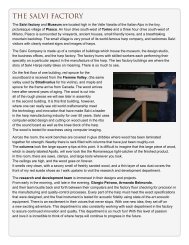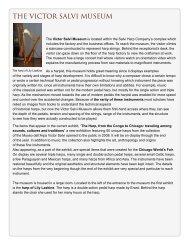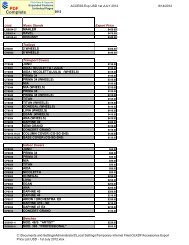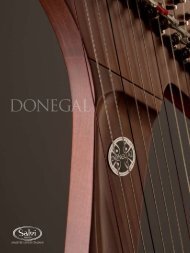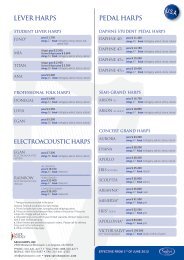Technical Maintenance and Care Guide - Salvi Harps, Inc.
Technical Maintenance and Care Guide - Salvi Harps, Inc.
Technical Maintenance and Care Guide - Salvi Harps, Inc.
Create successful ePaper yourself
Turn your PDF publications into a flip-book with our unique Google optimized e-Paper software.
itQuality born to lastQuality maintenanceitFRFRENDOESFor more than fifty years, the <strong>Salvi</strong> <strong>Harps</strong> br<strong>and</strong> name has become renownedfor excellence in sound worldwide.This is the result of a rigorous selection of materials combined with the developmentof proven construction methods to ensure optimal performanceof the instruments over time.Only natural materials from selected wood resources are used to build thestructure of a <strong>Salvi</strong> harp.Because wood is a living material - <strong>and</strong> therefore subject to climatic variations– criteria must be established to adequately preserve the quality of theharp’s sound over time.To construct the mechanism, <strong>Salvi</strong> has developed cutting-edge technicalsolutions so that moving parts work precisely <strong>and</strong> consistently over time,thereby maintaining perfect tuning.To achieve this, connection levers are built in high-strength steel, while thesliding parts are in a highly wear-resistant copper-zinc alloy.The high structural stress caused by the string tension calls for particularcare in the maintenance <strong>and</strong> moving of the instrument, while the complexityof the mechanical action requires regular revision to guarantee optimalperformance.The harpist is the main caretaker of his or her harp.Familiarity with one’s own instrument, together with the right informationconcerning care <strong>and</strong> maintenance, will allow you to identify possible problems<strong>and</strong> maintain your harp for years to come.This <strong>Technical</strong> <strong>and</strong> <strong>Maintenance</strong> Manual was compiled to help the harpistin getting to know his or her instrument. In the following pages you will findsome simple rules to follow for correct maintenance <strong>and</strong> a series of suggestionsto ensure that your harp functions correctly.To ensure the quality of the instrument <strong>and</strong> the continued perfection of thesound you may contact <strong>Salvi</strong>’s <strong>Technical</strong> Service with any questions or concernsyou may have.To contact the <strong>Salvi</strong> <strong>Technical</strong> Service:Tel +39 0175 270524mobile +39 335 5630215e-mail: service@salviharps.comENDOES6introductionintroduction7
ititFRFRFull regulation of the harpMoving <strong>and</strong> transporting your harpENDOESThe structure of the harp evolves constantly due to the nature of its materials.The overall stress of the strings amounts to about 1,200 kg for a ConcertGr<strong>and</strong> harp, a factor that influences the settling of the wooden structural part<strong>and</strong> on the movements of the internal parts of the mechanism.These factors become increasingly important when a harp is played severalhours a day or when it is transported.This settling may even cause minimal shifting of each individual part of theharp. This emphasises the importance of the instrument being periodicallyinspected by authorised <strong>Salvi</strong> Technicians, who have the necessary knowledge<strong>and</strong> expertise required to keep all the moving parts working freely,<strong>and</strong> are also trained to ensure that the structural parts are working properly,thereby guaranteeing functionality <strong>and</strong> perfect sound.It is advisable to carry out a full regulation of the harp once per year orat least once every two years, according to how much the instrument isactually used.By following a few simple rules, it is possible to move your harp without causingany damage whatsoever.The harp rests on the floor with 4 feet positioned on the base so as to guaranteethe correct balance of the instrument when it is being played.The front feet are equipped with wheels to facilitate any movement of theharp for short distances over flat <strong>and</strong> smooth surfaces without having to lift it;it will suffice to slightly tip the instrument forward (toward the column) to liftthe rear feet approximately 2 - 3 cm from the floor. In this way, the wheels willbe free to turn, making it possible to move the harp frontwards or backwardsfor a short distance.Remember to hold the harp firmly with one h<strong>and</strong> inside a sound hole <strong>and</strong>balance the instrument on the other h<strong>and</strong> placed firmly on the neck.When it is necessary to move the harp for longer distances or on roughersurfaces, it is advisable to use a special 2 or 6-wheel trolley, useful for eitherlevel surfaces or stairs.It is also possible to use the trolley without having protected the harp with itstransport cover; however, it is always advisable to use the cover to protectthe instrument. The trolley is equipped with belts that should be strappedaround the harp to limit the risk of instability <strong>and</strong> falling.ENDOESWhen the harp must be transported by car, it is always necessary to use itsindoor cover <strong>and</strong> complete transport cover to protect it from scratches orimpacts as well as from direct sunlight. If possible, the harp must be placedon one side, taking care to leave the discs upward, thereby avoiding potentialdamage to the strings <strong>and</strong> the mechanism.If the harp is to be entrusted to a transporter, it is recommended that a specialtrunk should be used. Always wrap the instrument in its indoor cover <strong>and</strong>transport cover to ensure maximum protection inside the trunk.For more information on the accessories described above, please contactyour retailer directly.18CARE AND MAINTENANCECARE AND MAINTENANCE19


